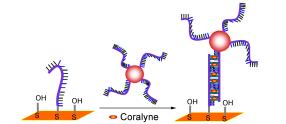| [1] Lv, Z. Z.; Wei, H.; Li, B. L.; Wang, E. K. Analyst 2009, 134, 1647. [2] Wilson, W. D.; Gough, A. N.; Doyle, J. J.; Davidson, M. W. J. Med. Chem. 1976, 19, 1261.[3] Xu, X.; Wang, J.; Yang, F.; Jiao, K.; Yang, X. Small 2009, 5, 2669.[4] Lin, Y. H.; Tseng, W. L. Chem. Commun. 2011, 47, 11134.[5] Wang, Y.; Wang, J.; Yang, F.; Yang, X. Anal. Chem. 2012, 84, 924.[6] Homola, J. Chem. Rev. 2008, 108, 462.[7] Situ, C.; Mooney, M. H.; Elliott, C. T.; Buijs, J. Trends Anal. Chem. 2010, 29, 1305.[8] Altintas, Z.; Uludag, Y.; Gurbuz, Y.; Tothill, I. Anal. Chim. Acta 2012, 712, 138.[9] Yang, X.-H.; Li, Z.-H.; Wang, Q.; Wang, K.-M. Acta Chim. Sinica 2007, 65, 1185 (in Chinese). (羊小海, 黎振华, 王青, 王柯敏, 化学学报, 2007, 65, 1185.)[10] Golub, E.; Pelossof, G.; Freeman, R.; Zhang, H.; Willner, I. Anal. Chem. 2009, 81, 9291.[11] Wang, Q.; Huang, J. H.; Yang, X. H.; Wang, K. M.; He, L. L.; Li, X. P.; Xue, C. Y. Sens. Actuators B 2011, 156, 893.[12] Wang, L.; Li, T.; Du, Y.; Chen, C.; Li, B.; Zhou, M.; Dong, S. Bio-sens. Bioelectron. 2010, 25, 2622.[13] Lyon, L. A.; Musick, M. D.; Smith, P. C.; Reiss, B. D.; Pe?a, D. J.; Natan, M. J. Sens. Actuators B 1999, 54, 118.[14] Kira, A.; Kim, H.; Yasuda, K. Langmuir 2009, 25, 1285.[15] Adam, B. S.; Tonya, M. H.; Michael, J. T. Anal. Chem. 1998, 70, 4670. [16] Wang, Q.; Yang, L. J.; Yang, X. H.; Wang, K. M.; He, L. L.; Zhu, J. Q. Anal. Chim. Acta 2011, 688, 163.[17] Zhou, Y.-W.; Li, C.-M.; Xiong, Z.-H.; Huang, C.-Z. Acta Chim. Sinica 2012, 70, 352 (in Chinese). (周亚文, 李春梅, 熊祖洪, 黄承志, 化学学报, 2012, 70, 352.)[18] Giri, P.; Kumar, G. S. Arch. Biochem. Biophys. 2008, 474, 183.[19] Yang, X. H.; Wang, Q.; Wang, K. M.; Tan, W. H.; Li, H. M. Biosens. Bioelectron. 2007, 22, 1106.[20] Storhoff, J. J.; Elghanian, R.; Mucic, R. C.; Mirkin, C. A.; Letsinger, R. L. J. Am. Chem. Soc. 1998, 120, 1959. |
